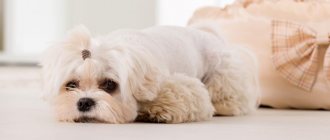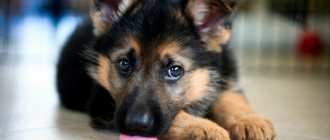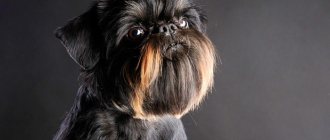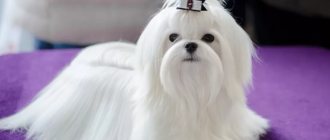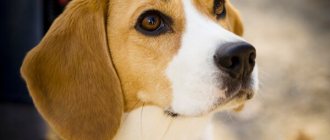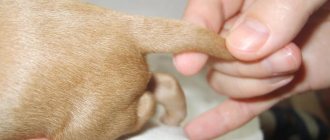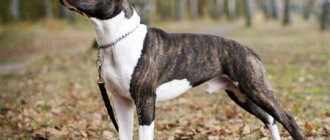More and more people are choosing small and medium-sized dog breeds for keeping them at home. They do not cause big problems in care and such a small pet can always be taken with you.
This type of breed also includes the Maltese (Maltese). Read more about this dog breed in our article.
Characteristics
A detailed description of the breed is specified in the FCI standard No. 65 dated 04/06/1998, according to which the Maltese belongs to the group of indoor decorative dogs and companions. Among other small breeds, the Maltese definitely stands out due to its luxurious long coat.
Dogs of this breed are quite active, kind and affectionate. They can get along well with other animals, as well as with children. Thanks to its small size, it is ideal for keeping even in a small apartment.
Color
According to the standard, the Maltese dog has only one coat color - white. The only exception may be a light shade of ivory. All additions of color are considered disqualifying marks. The presence of light orange or other types of markings of any size on the coat is not allowed.
Dimensions
Maltese dogs are considered decorative dogs, and this immediately indicates their small size. Height at the withers is:
- males – from 20 to 25 cm;
- females – from 17 to 23 cm.
The Maltese is a small dog with a rectangular body, which according to the standard must have the following proportions:
- body length is 38% greater than the height at the withers;
- the length of the head is 6/11 of the height of the animal at the withers;
- the length of the skull should be 3/11 greater than the length of the muzzle.
Important! Deviation of height from the parameters specified in the standard, more or less, is considered a disadvantage.
Weight of adults and puppies
The weight of an adult dog does not exceed 3-4 kilograms. The weight of puppies in the first month of their life is comparable to the weight of small kittens and is approximately 200-500 g, depending on the week from birth.
Other characteristics
- Of course, the most distinctive feature of the breed is the Maltese's coat. The body is very abundantly covered with shiny and silky hair. The hair is completely straight without any curls. The average length is 20 cm, and the maximum should not significantly exceed the height of the dog at the withers. Long hair should cover the animal's body, forelimbs, head, neck and tail well. There should be no protruding tufts on the dog’s body; all hairs are located close to the body and directed towards the floor. Only the main lines of the body should be visible under the fur.
- The Maltese's eyes are very expressive and quite large, with a round shape. The eye color is dark and the eyelid has a black rim. The eyes should be well open and not deep set.
- The Maltese's ears are flat, triangular in shape, hang smoothly and fit tightly to the coat. The length of the ears is approximately ⅓ of the height of the animal at the withers. The ears are set very high and covered with the same long hair as on the body. Its total length should reach the shoulders.
- The Maltese's tail is thick at the base and becomes noticeably thinner towards the tip. Its length is slightly less than ⅔ of the dog's height at the withers. The tail has a slight bend, its rounded end touching the body. The tail is densely covered with long hair that falls to one side of the body.
Important proportions:
· The oblique length of the body exceeds the height at the withers by more than 15%.
· The length of the muzzle is slightly more than 1/3 of the length of the head.
· The height of the forelimbs from the elbow to the ground is approximately equal to half the height at the withers.
· The depth of the chest is equal to, for example, half the height at the withers.
BEHAVIOR/TEMPERAMENT: Affectionate dog with a lively temperament and cheerful disposition.
HEAD: Proportional to overall build.
CRANIAL PART:
Skull: Round in shape, slightly convex, the occipital protuberance is weakly expressed, the brow ridges are moderately pronounced.
Transition from muzzle to muzzle (stop): Short, well defined.
FRONT PART:
Nose: The nose is small, black or to match the color. The nostrils are well open.
Varieties of the Maltese: description and photo
There are two varieties of the Maltese breed - American and English. English is considered classical. The American lapdog differs from the English lapdog in its slightly smaller size and coat type.
Also, during the breeding process, it was possible to obtain 2 types of Maltese: mini and standard. From the name it becomes immediately clear that the main difference between them is the size of the animals, and other features of the breed remain unchanged.
What does the mini look like?
The miniature snow-white Maltese is considered a very ancient breed. The first exhibition in England with the participation of these dogs was held in 1862. Due to their luxurious appearance, the dogs were popular with royalty. Representatives of the fair sex loved to show off miniature dogs dressed in jewelry in public.
So that the ladies did not have to carry large and heavy animals with them, the smallest ones were selected from among the representatives of the breed and only they were used for further breeding. Thus, over the years, an exclusively miniature Maltese was bred, which was no longer crossed with the standard Maltese. The Mini Maltese is smaller and lighter than its standard-type predecessor.
Important! The height at the withers of miniature dogs does not exceed 15-20 cm, and the weight is 1.5-2.5 kg. Males are several centimeters (2-3 cm) taller than females. In character, these two types of lap dogs are no different.
This is a photo of a mini maltese that looks like a small soft toy:
And this is a photo of a dog near the Christmas tree:
And another photo of a dog with a big red bow:
Difference between mini and standard
The Mini Maltese is an exact copy of its relative, the Standard Maltese, only in a smaller form. Snow-white long hair, expressive large eyes, hanging flat ears - all this is inherent in both representatives of the breed.
The miniature lapdog adopted all the external characteristics and character traits from the standard Maltese. There are only a few differences between them:
- Height at the withers. An adult standard-type dog can reach 23 cm at the withers, and a mini Maltese, as a rule, does not grow more than 20 cm in height.
- Weight. Miniature lap dogs are almost two times lighter than their counterparts. Their weight is 1.5-2.5 kg, while the Maltese has a standard weight of 3-4 kg.
- Price. Tiny dogs are widely in demand, which is why their prices are higher. The smaller the size, the more expensive the pet is.
The difference in price between standard and mini puppies can reach several tens of thousands of rubles.
In the photo there is a mini Maltese:
In the photo there is a standard Maltese:
And this is a representative of this species with a long hairstyle:
Are there micro?
Conventionally, Maltese dogs are divided into three types: standard, mini and micro. The height of the latter is set between 14 -16 cm, and weight - 1.3-1.5 kg. However, breeders in nurseries claim that such dwarfism in animals is created artificially, since there is a great demand for very miniature dogs, but behind this lies a lot of problems with the health of the animal.
Important! There is no official variety of Micro Maltese.
Unscrupulous breeders deliberately crossbreed animals born with insufficient height according to the standard. After this, they pass on to their offspring a full set of diseases that lead to dwarfism (problems with joints, underdevelopment of internal organs, etc.). Such animals can live no more than 3-5 years, but provided that they are provided with proper care.
In the photo there are two adorable micro Maltese playing:
And this is them all sitting together in a basket:
And this little naughty girl climbed into a small vessel and looks around:
Maltese loses weight
reasons snow-white Maltese weight loss : from banal worm parasites to diabetes. Weight loss can be caused by a viral infection or thyroid dysfunction. If weight loss is accompanied by diarrhea and stool retention, then anthelmintic measures and research for dysbacteriosis or fungi are necessary. If, against the background of general weight loss, the dog is thirsty and constantly hungry, a blood sugar test will reveal diabetes. Only laboratory tests enable the veterinarian to confirm the diagnosis, draw up a plan for wellness procedures and obtain optimal treatment results.
Maltese mix
Mestizos, like ordinary mongrels, are not considered purebred animals. But there is a significant difference between them. In the pedigree of mestizos there are purebred parents, unlike mongrels. External characteristics of the breed can be transmitted from a purebred father or mother, but even with maximum similarity, such animals cannot have documents confirming their belonging to the breed.
It is believed that mestizos inherit from their parents the best characteristics not only in physiology, but also in character.
Mestizos have stronger immunity, do not have diseases characteristic of any particular breed, they adapt faster to a new environment and are less aggressive. Among the Maltese mix breeds, the following options exist:
- Metis Mi-ki. He was specially bred as a cross between a Maltese, Papillon, Shih Tzu and Japanese Chin. This dog is very popular. The price of mixed-breed Mi-ki puppies reaches 150 thousand rubles. These dogs have straight, floor-length fur and funny butterfly-shaped ears. The appearance turned out to be very cute, and the character was friendly.
- A cross between a Yorkshire Terrier and a Maltese. Such mestizos are usually called Morkies or Yorkties. The animal has good physical endurance and good health. Carrots have an affectionate character, they get along well with others and are very attached to their owner. They inherited some stubbornness from the Yorkies.
- A cross between a toy terrier and a lapdog. Mixed breeds of these two breeds have long hair and look more like a Yorkshire terrier. By nature they are kind and trusting, they feel comfortable in the company of children.
- Pekingese and lap dog mix. The result of such crossing is small fluffy dogs, full of affection and activity. They know how to listen to their owner and are easy to train. Relationships with children will depend on the play of genes. If the lapdog genes predominate, the animal will show love for children; if the Pekingese genes, the dog will be passionate about itself and its owner.
- Maltipoo. This is the name of a cross between a poodle and a lapdog. As a result of crossing, they can get either straight wool or slightly wavy or noticeably curly hair. Externally, the dog looks more like a lapdog. She has good intelligence, is very playful and curious.
This photo shows a Maltese mix:
Here is the cream color of the Maltese mix:
And the color of this mestizo contains black:
How to choose a puppy
Maltese: how to choose a puppy
Maltese is a fairly popular breed, which is bred by many breeders. To become the owner of a purebred and healthy puppy, it is better to buy it from an officially registered nursery.
At the time of sale, the baby must already have documents confirming its origin and availability of scheduled vaccinations.
When choosing a Maltese puppy, it is recommended to pay attention to:
- Conditions for keeping mother and puppies. The room where little Maltese live should be clean, warm, light and dry.
- Appearance. A Maltese puppy must fully comply with the breed standard and be similar to its parents. It is important that they have dark shiny eyes, smooth paws, a black wet nose and snow-white, absolutely straight fur. You should not choose the fluffiest puppy from the litter, since an excessively voluminous coat is considered a disadvantage. But a slightly wavy coat may straighten out as the dog gets older.
- Characteristics of puppies. Kids should be friendly, inquisitive, playful and active. It is important that they do not sit, scared, huddled in a corner, but easily make contact and show a healthy interest in everything that is happening.
Comparison with other small dogs
It is most relevant to compare the Maltese with other small breeds that have at least some similarities with each other. So, for example, lap dogs are a little similar to Yorkshire terrier dogs. They also have long hair, which requires proper care, and expressive, dark, round eyes. But there are a number of differences:
- smaller Yorkie;
- A terrier can be of different colors, but a lapdog can only be white;
- There are many restrictions in the Maltese's diet and a special approach is required, while Yorkies are absolutely not picky about food.
Yorkshire Terrier in the photo:
If we compare the Maltese and the Bichon Frize, the similarities between them lie in their pretty appearance, white color and character. Both breeds are very friendly, affectionate and loyal. But there are also quite obvious differences between them:
- The lapdog's coat is long and smooth, while the Bichon Frize's coat is curly and elastic;
- The lapdog is smaller in size than the bichon; the height at the withers of the latter can reach 30 cm;
- The price of Maltese puppies is higher than that of Bichon Frize.
The Shih Tzu breed is considered as popular and expensive as the Maltese. Both breeds require special coat care. The Shih Tzu weighs almost twice as much as the lapdog. Adult dogs weigh 6-8 kg, but their height at the withers is only a few centimeters higher than that of the Maltese (28 cm for the Shih Tzu).
Important! The Maltese shows devotion to one owner, and the Shih Tzu communicates equally with all family members.
The Shih Tzu breed is characterized by a wider palette of shades, in contrast to the Maltese's exceptional white color.
The Maltese, like many small dog breeds, is very popular. The friendly nature and compact size make it possible to keep the dog in an apartment and even in the presence of children. She gets along well with other family members and is calm around other animals. Maltese mixes with other breeds of small and medium-sized dogs are no less cute and affectionate.
Characteristics of Maltese dogs. What is the difference between mini and standard?
More and more people are choosing small and medium-sized dog breeds for keeping them at home. They do not cause big problems in care and such a small pet can always be taken with you.
This type of breed also includes the Maltese (Maltese). Read more about this dog breed in our article.
Useful video
Watch the video for all about the Maltese breed:
Small, playful dogs have a special place in any family, being kept as a friend and companion. Judging by the reviews of our readers, the Maltese, or Maltese, looks great in this role, its behavior and beauty are winning admirers all over the world. Even at large canine exhibitions, where a huge number of all kinds of breeds gather, the Maltese always attracts attention - these snow-white dogs look so luxurious, elegant and confident. It is impossible to tell everything about the breed in one article, so read a large series of articles about Maltese on our website.
History of the breed
Since the history of the Maltese breed is rooted in the deep past, there is no reliable information about its origin. Thanks to ancient excavations, scientists have found that dogs similar in appearance to modern Maltese dogs existed before our era.
This is evidenced by figurines and wall paintings of miniature dogs with long hair, discovered in the Mediterranean burials of wealthy citizens and kings. The Maltese is believed to be close in age to the Molosser, recognized as the progenitor of many extinct and still existing dog breeds.
The opinion about the origin of dogs on the Mediterranean island of Malta cannot be considered the only correct one, although the breed is called the Maltese. The version about the origin of the breed on the island of Meleda (Croatian - Mljet, Latin - Melita) in the Adriatic Sea has a right to exist.
Be that as it may, beautiful dogs gradually appeared in different countries. But they were not suitable for hunting, searching, guarding, fighting, that is, they did not perform any official functions, which means that ordinary townspeople, and especially peasants, had no need to have them. Only wealthy people kept them, sparing no expense on their amusements - so Maltese became a symbol of luxury, wealth and good taste .
Snow-white puppies were presented as gifts to kings, queens, aristocrats and high clergy, and were exchanged for expensive goods or privileges. For example, it is known that a long-haired lapdog lived with one of the bishops of Malta, Queen Victoria of England, and the Scottish Queen Mary Stuart was accompanied by a dog of the Maltese breed to the place of execution.
A limited number of livestock and “greenhouse” living conditions contributed to the preservation of the original qualities of the breed almost unchanged. There are only slight differences between the American and European breed standards; they have arisen as a result of separate breeding in America over the past decades.
Options
The main difference between the two standards, European and American, concerns the weight of dogs . Thus, the European (read – international, classical) standard speaks of a limit of 3–4 kg, while the American one insists on an acceptable weight of only 1.8–2.7 kg.
In all countries except America, the data of the European standard, that is, the International Canine Federation (FCI), is recognized. According to their version of the sizes, the height of males should be within the range of 21–25 cm, for females these limits are 2 cm lower.
Now I’ll tell you how to calculate the weight of an adult Maltese. For European standard use this table:
The life expectancy of small dogs with good care reaches 15 years. The price of show dogs is very high. Read more about prices for this breed here: https://pesikmal.ru/interesno/ceny-malteze.html.
Show breed standards
According to the FCI classification, the Maltese breed, like the Mini Maltese, belongs to group 9 “Ornamental and companion dogs”.
The body is moderately elongated, the flowing hair hides all the contours of the body. The back is straight, the croup is slightly lowered towards the hips.
The withers are not clearly defined, the neck is straight. The sternum is spacious, reaching the line of the elbows. The limbs are well developed, with flexible joints and moderate muscles. The paw pads are black, the claws are dark (preferably black). The tail is saber-shaped, curved upward, touching the back, thinned towards the end.
The skin of lapdogs is without folds; spots of pigment are allowed. Lips are black and dry. The teeth are straight, white, without gaps. The nose is black and small. Eyelids black. The eyes are rich brown, with a rounded cut. The ears are triangular with rounded tips, semi-erect; in a calm state they are pressed to the head, in an excited state they are raised and directed forward.
Description and characteristics of the breed
When describing the Maltese, the first thing that comes to mind is a comparison with a toy, a snowflake. The long-haired, mature dog is graceful, noble and very attractive.
Like another white dog, the Bichon Frize, the Maltese has no undercoat, so the risk of allergies to this dog is minimal . Still, given the variety of allergic reactions to animals (this could be an allergy to urine or skin secretions), before purchasing a dog for a family with allergies, breeders recommend talking to the puppy. This will help avoid a difficult separation from your pet in the event of allergic reactions in family members, especially young children.
If there are children in the family, then it is necessary to teach them how to handle the dog carefully. The Maltese does not attack members of its family, but children can carelessly injure a small dog.
Coat type and color
The Maltese's body is completely covered with long flowing hair, like a cloak. In show dogs, the fur reaches to the tips of the paws, completely covering them. The coat should be smooth, long, silky, heavy, and its structure should be dense. There is no undercoat, the outer hair lies flat, without curling. Only on the lower part of the paws is the fur allowed to be slightly ruffled or wavy. The hair on the head and face also grows long.
Unlike Shitzus, Maltese dogs that meet the breed standard are found in white, ivory or beige. But in controversial situations, snow-white dogs always have an advantage, because when compared, the coat of beige lapdogs looks a bit dirty.
Advantages and disadvantages
The undoubted advantages of Maltese include their ability to learn to go to the toilet in a diaper or in a litter tray. This is very helpful when the owner is away for a long time or during bad weather.
Even a litter box trained dog should go for long walks. She needs to throw out her energy, “talk” with other people’s dogs and people. In the absence of walks, dog activity will result in chewed things, wires, and torn pillows.
Another plus is the dog’s friendliness towards familiar people, especially children. Many guys perceive the lapdog as their friend, loyal and cheerful.
Do not forget about the small size of the animal, which means low food costs . And thanks to their miniature dimensions, lap dogs easily take root even in one-room apartments.
Since the Maltese's coat is devoid of undercoat, they do not have problems with seasonal shedding. Dead hairs fall out, but their quantity is very small and cannot be compared with many dog breeds.
The disadvantages of the breed include possible aggression and uncontrollability with insufficient education. Although this same point can be chalked up to a lazy or indifferent owner who missed the process of socialization and obedience.
The most difficult thing in caring for a pet is taking care of the coat, which requires daily attention.
Nicknames
A well-chosen dog name can reflect its character and habits. Remember, this is a dog of aristocratic origin, which means its nickname must be appropriate.
A nickname is a kind of command that the dog will hear throughout its life. It should be easy to pronounce, correspond to the gender of the pet and be harmonious.
You should not call a Maltese by a human name, much less by the name of a previously deceased pet. Comic nicknames are also not suitable, because they can provoke an embarrassing situation when in public. Believe me, by looking into the dog’s button eyes you will immediately understand what nickname it needs.
The most common nicknames for boys:
- Austin.
- Monty.
- Vander.
- Cake.
- Roland.
Popular names for girls:
- Charlie.
- Lucy.
- Blondie.
- Emmy.
- Zhully
Character
Maltese has a light, lively character. They love outdoor games, especially at a young age, they love to run and jump. They rush along the street in order to learn as much as possible, so that nothing escapes their attentive, curious gaze.
Although dogs are small, they are very loyal and sincere, they love their owner, his family and friends . They treat strangers with caution or indifference, and often bark at them. This happens not because of well-developed guard qualities, but solely due to character, this is how they express their dissatisfaction or desire to communicate.
Training
A well-mannered dog always behaves with dignity, confidence and in accordance with the situation. Unfortunately, owners of small dogs often leave training to chance, limiting themselves to walking or litter box training and minimal commands such as “sit” or “lie down.” This is not enough to raise a socialized dog that feels comfortable in the city and society without aggression or cowardice. Since childhood, a dog must be familiar with other animals, especially cats, must know the commands “near”, “come to me”, not rush at people, and also run away from cars.
In the case of the Maltese, training is not difficult, so the owner can do it himself. If there are no training skills and the help of specialists is needed, you should use the services of instructors who conduct both individual and group OKD classes (general training course). This is especially important for dogs that have prospects for a show career, because at the show their behavior must be impeccable, otherwise disqualification will follow. In addition, the courses will tell you how to learn simple tricks with an active and active pet.
In the absence of training, an angry, ill-mannered dog may grow up in a family, attacking strangers and even the owner’s children, not to mention animals . Otherwise, Maltese will become your best friend and an irreplaceable family member.
Care and maintenance
A decorative dog can only live in a warm apartment or house.
When looking at a well-groomed Maltese, many people focus on their long, silky coat. Usually they grow it long for dogs participating in exhibitions; short hair is unacceptable for them. Long hair requires special attention: daily combing, drying, washing. For ordinary pets, it is not necessary to grow long hair:
- it's troublesome;
- Dogs are hot in summer.
Non-show dogs are usually cut short before the summer so that their fur grows in time for winter. It is recommended that both dogs be thoroughly combed daily with a comb. It is worth washing as needed when the lapdog gets dirty.
The ears require attention; plan to clean them at least twice a month. With the same regularity, you need to inspect and, if necessary, trim the claws.
In the summer, dogs that walk on asphalt, on which their claws wear off a little, are spared from this procedure. If you notice problems with the eyes (redness, watery eyes, frequent blinking), you should immediately contact a veterinarian. In addition to serious health consequences, diseased eyes look unsightly: flowing tears turn the fur on the cheeks brownish.
To keep dogs' teeth clean, they buy hygienic treats that not only scratch their teeth, but also remove plaque from them. When tartar appears, you will have to remove it chemically or mechanically in a veterinary hospital, otherwise caries will quickly develop under the stone, and then stomatitis is not far away.
In cold regions of the country, many decorative dogs acquire a personal wardrobe. Thus, to keep their long fur clean and dry, show dogs walk in overalls made of warm and waterproof fabric, some in boots.
When spring comes, lap dogs are treated against ticks and fleas. It comes in the form of drops or special collars soaked in chemicals.
Feeding
The owner determines the way the Maltese dog eats, taking into account his financial capabilities, the dog’s preferences and the recommendations of the veterinarian. Natural food is cheaper than high-quality industrially produced food, but it takes time to prepare . If the food is of average or low quality, and there is no opportunity to provide natural food, then it is necessary to add vitamin complexes to the diet.
| Age (weeks) | Dog's current weight (grams) | |||||||
| At birth | 99 | 113 | 120 | 127 | 142 | 156 | 170 | 184 |
| Week 1 | 156 | 184 | 198 | 226 | 255 | 269 | 290 | 311 |
| Week 2 | 198 | 255 | 283 | 311 | 354 | 382 | 410 | 453 |
| Week 3 | 255 | 311 | 368 | 396 | 452 | 495 | 524 | 566 |
| Week 4 | 311 | 368 | 425 | 481 | 538 | 594 | 651 | 679 |
| Week 5 | 368 | 425 | 481 | 552 | 623 | 679 | 736 | 821 |
| Week 6 | 425 | 495 | 566 | 623 | 736 | 764 | 849 | 906 |
| Week 7 | 481 | 552 | 623 | 693 | 764 | 849 | 934 | 991 |
| Week 8 | 538 | 608 | 679 | 764 | 821 | 934 | 1019 | 1103 |
| Week 9 | 566 | 651 | 736 | 821 | 906 | 991 | 1103 | 1189 |
| Week 10 | 623 | 708 | 792 | 877 | 962 | 1075 | 1160 | 1274 |
| Week 11 | 679 | 764 | 877 | 962 | 1047 | 1132 | 1274 | 1387 |
| Week 12 | 736 | 849 | 934 | 1047 | 1160 | 1274 | 1387 | 1450 |
| Week 13 | 792 | 906 | 1019 | 1132 | 1245 | 1387 | 1450 | 1613 |
| Week 14 | 849 | 962 | 1104 | 1217 | 1330 | 1472 | 1585 | 1698 |
| Week 15 | 906 | 1047 | 1160 | 1302 | 1443 | 1585 | 1726 | 1840 |
| Week 16 | 962 | 1104 | 1245 | 1387 | 1528 | 1670 | 1840 | 1981 |
| Week 17 | 1019 | 1160 | 1302 | 1443 | 1613 | 1755 | 1896 | 2038 |
| Week 18 | 1047 | 1217 | 1358 | 1528 | 1698 | 1840 | 2009 | 2151 |
| Week 19 | 1104 | 1245 | 1415 | 1585 | 1755 | 1896 | 2038 | 2179 |
| Week 20 | 1160 | 1302 | 1472 | 1641 | 1528 | 1981 | 2151 | 2292 |
| Week 21 | 1189 | 1358 | 1528 | 1698 | 1868 | 2038 | 2207 | 2377 |
| Week 22 | 1217 | 1387 | 1585 | 1755 | 1924 | 2094 | 2264 | 2434 |
| Week 23 | 1245 | 1415 | 1613 | 1811 | 1981 | 2151 | 2320 | 2490 |
| Week 24 | 1274 | 1443 | 1641 | 1840 | 2009 | 2207 | 2377 | 2547 |
| Week 25 | 1302 | 1472 | 1670 | 1868 | 2038 | 2236 | 2434 | 2632 |
| Week 26 | 1330 | 1450 | 1698 | 1896 | 2066 | 2264 | 2462 | 2660 |
| Adult dog | 1588 | 1814 | 2041 | 2268 | 2495 | 2722 | 2948 | 3175 |
| Few | Norm | A lot of | ||||||
What to feed?
Until 1.5-2 months, puppies feed exclusively on mother's milk.
Starting from 6 weeks, it is permissible to introduce complementary foods. You can offer your puppy low-fat cottage cheese, sour cream, fermented baked milk, and kefir. Meals 5-6 times a day. Try to set regular feeding times to help your dog develop a routine. Afterwards, you can offer your dog boiled vegetables, chicken eggs and meat in addition to the main diet. If the reaction is positive, then they can replace 1 feeding. Breeders often introduce dry food into a puppy’s diet, replacing one feeding. At 3 months, the puppy should eat at least 4 times. When the dog gets to the owner, he should immediately decide on the type of food: dry food or natural.
When handing over a dog to a new owner, breeders give recommendations regarding feeding.
If the dog is on ready-made food, then there are no difficulties. Super-premium and holistic food is recommended for the Maltese dog. Among these foods you can find dedicated lines for puppies. Giving preference to natural food, it is necessary to think through the dog’s diet in advance so that it receives all the necessary components and nutrients.
That is, the dog’s diet should consist of:
- 50% meat or fish;
- 20-25% dairy products;
- 20-25% of plant and grain crops;
- 5-10% fruits and berries.

